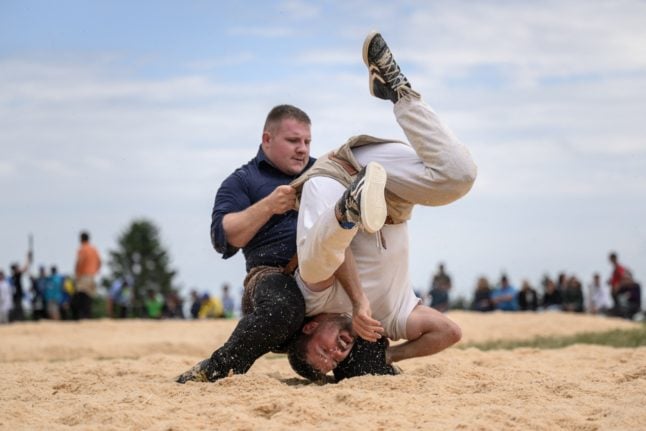While relatively unknown outside of Switzerland, and largely concentrated in the country’s German-speaking cantons, Schwingen is Switzerland’s homegrown form of wrestling.
In a sawdust ring, two competitors aim to throw each other onto their backs, with both shoulders touching the ground. Each time this is achieved, a point is awarded to the victor.
All this throwing is achieved by grabbing the leather belt attached to the jute shorts worn by the combatants.
As simple as this sounds, there are several styles of Schwingen and hundreds of recorded holds and grips. Size and strength play a significant role in Schwingen, but flexibility cannot be discounted as a factor in determining a champion.
A proud history
Like any martial art, the origins of Schwingen are lost to history, but it’s safe to say that just like the Schuhplattler of neighbouring Bavaria – that’s the slappy lederhosen dance – it’s been around for thousands of years, practised by mountain tribes, and later shepherds tending mountain flocks.
The first depictions in art date from the 13th century and the first written records from the late fifteenth and early sixteenth century, when local church authorities sought to crack down on the rowdy celebrations that these competitions were associated with.
Indeed, Schwingen was massively restricted for hundreds of years, under the fear that it was leading to drunkenness and all manner of other sinning. The large majority of Schwingen meets at this time took place in isolated areas, far from prying eyes.
All of this changed with the arrival of industrialization, railways and tourism. With many flocking to rural Switzerland for the beauty of outdoor spaces and quaint local customs, Schwingen was brought back to the cities by fascinated spectators and became so popular that it needed to be codified and organized to regulate it.
To this end, the Schwingerverbandes, or Federal Wrestling Association was founded in 1895.
Read More: Schwingen: Everything you need to know about Switzerland’s ‘national sport’
More popular than ever
Schwingen is now a very popular sport within Switzerland, practised by a dedicated core of amateurs and professionals, and watched by far, far more,
Experiencing a further boom throughout the 20th century, boosted by broadcast media, it became mass entertainment. It’s a televised sport, revolving around several key meets, at the canton and federal levels. In addition to youth Schwingen, there have been women’s competitions since 1980.
The Federal Swiss Wrestling and Alpine Festival is the apogee of competitive Schwingen, held every three years – think of it like a Swiss Olympics. The next will be in Glarnerland in 2025.
Another massive event for Schwingen fans is the Unspunnenfest, held every twelve years in Interlaken. The next of these will be held in 2029.
Crowned in 2022, Joel Wicki from the canton of Luzern is the current Swiss Schwingen champion. Topping out at just over six feet, and weighing in at 110kg, he’s far from the biggest contestants – but then again, it’s not always strength that matters in a Schwingen bout.
Want to get involved?
While Schwingen isn’t exactly the kind of thing that international visitors generally involve themselves in, there is a fully packed calendar of events throughout the year for spectators.
These range from indoor events in the winter months, to the larger outdoor competitions during the summer. You can find out more on the Federal Wrestling Association’s website.
You can also track Schwingen competitions, and find out where to watch them on TV or online, via Sport.ch.



 Please whitelist us to continue reading.
Please whitelist us to continue reading.
Member comments